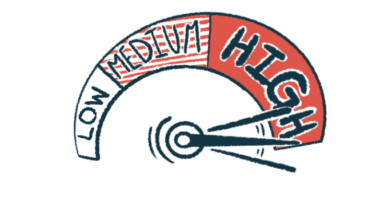Nervous system involvement is common in Pompe disease: Study
Researchers reviewed 81 studies that included LOPD, IOPD patients

Involvement in the brain and spinal cord’s white matter is common in Pompe disease, particularly in the infantile-onset form, according to a review of published studies.
Other affected parts of the brain and spinal cord, or central nervous system (CNS), were the gray matter and blood vessels in the brain, with symptoms including hearing impairment, seizures, strokes, hemorrhages, and cognitive delays.
“Standardized protocols are needed to characterize CNS involvement and adopt proper care strategies,” the researchers wrote in the study, “The involvement of Central Nervous System across the phenotypic spectrum of Pompe disease: a systematic review,” which was published in Neuromuscular Disorders.
In Pompe, genetic mutations disrupt the production or function of GAA, an enzyme that breaks down glycogen, a sugar storage molecule. Without sufficient GAA activity, glycogen builds up in cells, particularly in muscle cells, leading to muscle weakness and poor muscle tone.
The disease can also affect cells in the CNS, causing cognitive problems. A MRI analysis found white matter involvement in the brain of infantile-onset Pompe disease (IOPD) patients, which was linked to elevated blood levels of the neurofilament light chain (NfL) protein, a biomarker of nerve damage.
Here, researchers in Italy reviewed the published literature on CNS involvement in people with Pompe because “a clearer understanding of such involvement would be beneficial for proper monitoring and potential use of novel outcome measures in clinical trials.” They selected 81 studies from 1965 to 2024. Half (48%) included 271 IOPD patients, about 1 in 3 (36%) involved 265 late-onset Pompe patients (LOPD), and the remaining ones focused on both, with 91 patients. The patients’ ages ranged from 1 month to 68 years.
Studying nervous system involvement in Pompe disease
Twenty-four of the studies reported symptoms related to the CNS. In IOPD, studies described cognitive developmental delay and hearing impairment in one or both ears, with a prevalence ranging from 10% to 62.5%. Among LOPD patients, studies reported seizures, strokes, hemorrhages, and hearing loss. No visual disturbances were reported in the studies.
Of the 41 studies that focused on neuroimaging (CT or MRI scans), 25 reported white matter lesions (damage), with a prevalence ranging from 40% to 100% in IOPD and 5% to 22% in LOPD. Lesions in the gray matter — which includes cell bodies of neurons, nerve fiber endings and information-receiving structures called dendrites — were documented in all IOPD studies. Some LOPD studies noted mild brain atrophy (shrinkage). Abnormalities in blood vessels in the brain were also noted, mainly in LOPD patients, with a prevalence ranging from 11% to 60%. One study reported such abnormalities in 9% of IOPD patients.
Regarding cognitive function, 14 studies reported IQ scores that ranged from normal to extremely low in IOPD and from normal to low average in LOPD. Executive function (planning/organizing/decision making), visuomotor skills, and academic levels ranged from normal to impaired. The findings also included motor developmental delays, speech delays, and learning difficulties.
Twenty-one studies reported pathology observations of CNS tissue, including from the forebrain, brainstem, spinal cord, and eye. Glycogen accumulation was found in nerve cells, which appeared ballooned and degenerating. Other involved CNS cells included astrocytes, which support nerve cells, and oligodendrocytes, a type of cell that produces myelin, a fatty coating around nerve fibers. Areas affected included the cerebrum, the largest part of the brain, the spinal cord, the brainstem, and, to a lesser extent, the cerebellum at the back of the brain.
Some studies reported detailed glycogen deposits in the walls of blood vessels in the brains of LOPD patients, and one postmortem study described glycogen buildup in the eyes and optic nerves of an IOPD fetus.
Two studies tested NfL levels in IOPD patients. One showed NfL levels increased over time, but there was no correlation between NfL levels and brain MRI abnormalities. The second one found correlations between NfL levels, brain MRI findings, and IQ scores.
“We suggest that, as done for motor, cardiac, and respiratory function, [the CNS] should be assessed at baseline and in regular follow-up in all new [Pompe disease] diagnoses both in infantile and adult subjects,” the researchers wrote, noting this can be done with a “core set of imaging … and cognitive function evaluation with standardized tests selected for age range of patients.”







